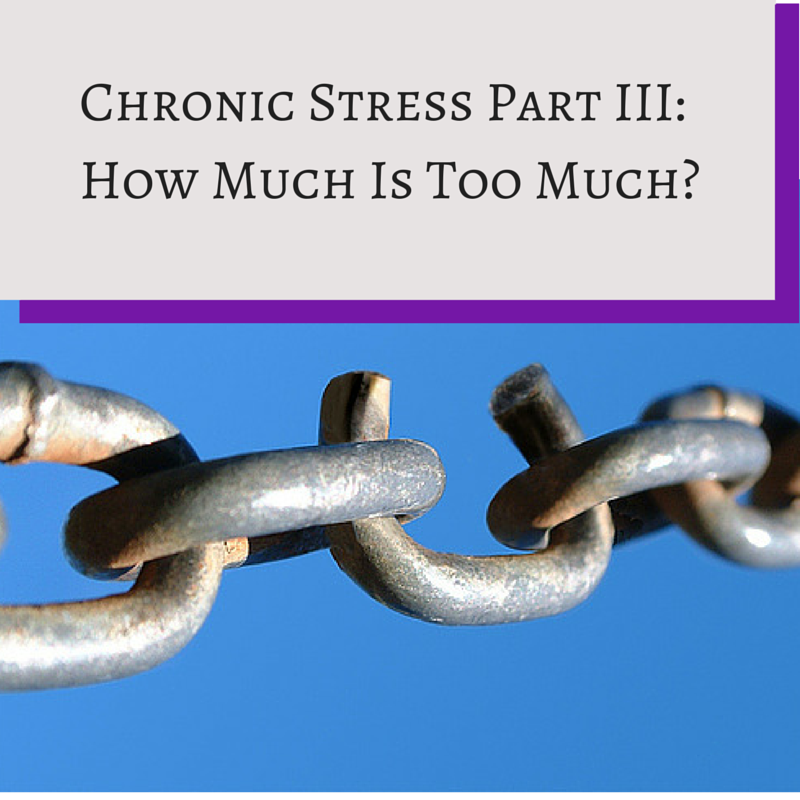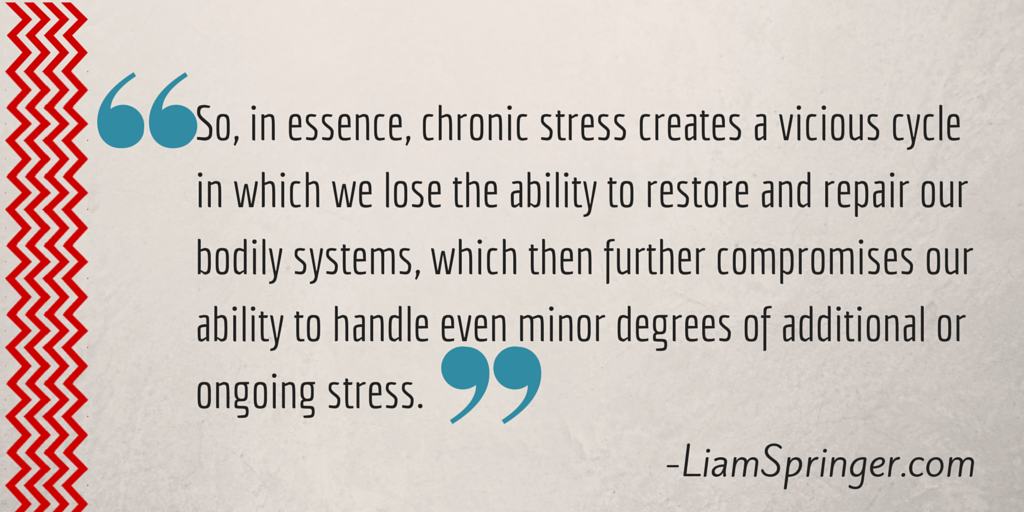
In my last two posts on stress I outlined the syndrome of chronic stress and how it can occur. I will now review these in order to outline how I believe the chronic stress state may be at the root of disease. These diseases may seem unrelated, but are in fact initiated by the onset and aggravation of the stress state.
Remember, there is a certain amount of challenge present at all times, and there are certain functions that must occur in the body in order to sustain life. If the level of challenge is increased beyond the body’s ability to meet it, then a compromise of optimal function can occur, with adaptive actions allowing for the body to temporarily prioritize meeting the increased demand. This is called the stress response.
An example of one of our normal daily challenges is cellular respiration. Every cell in our body needs energy, and the process by which our cells convert “food” into energy is cellular respiration. This is the driving force for our metabolism and the actions of life. So, at a very basic level, our ability to perform this function well and efficiently determines not only the health of an individual cell, but also our overall state of health of our body as a system of cells. If we are chronically stressed, our cells are no longer able to efficiently convert “food” into energy. Since this may occur in every cell in our body, to a variable extent, you can see how we may become “run-down”, tired, and eventually sick when chronically stressed.
So, how does this happen exactly?
How does chronic stress impair our bodily functions and lead to disease?
Remember that our bodies are well equipped to handle both ongoing, physiologic challenges such as nourishing the body and organ function, and intermittent acute, non-physiologic stress. These non-physiologic stresses can include things like injury, surprise, and skipping a meal. We get into trouble when the stress is chronic. When this happens, a sequence of events happen that ultimately leads to overt disease:
-
Incomplete recovery and repair from a stressor
-
Decreased ability to meet the similar future demands placed on the body by a challenge.
-
Accumulation of damage to the body due to incomplete recovery and repair and continued attempts to meet the ongoing stressful challenges
-
Further decline in the ability to meet challenges present
-
Progressively more rapid accumulation of damage to the body due to a declining ability to restore and repair both the previous damage and the progressing damage
-
Progressive bodily dysfunction, including specific tissues and their related organs, and overt illness
Let’s look at a simple example which can illustrate this concept. You are asked to hold your arms outstretched and hold a bucket of water in each hand. If you are young and strong, you may be able to do this for several minutes. However, eventually the chronic, unrelenting demand placed on you by this task will cause you to have to drop the buckets of water. For the next few minutes, it feels so much easier to keep your arms up and outstretched (since you have dropped the buckets of water). Still, even this lesser but constant stress will cause your arms to feel like lead, begin to shake, and eventually drop heavily to your sides. Thankfully, you are allowed to let your arms fall, and your muscles can recover, but what if you weren’t allowed to drop your arms? What if you weren’t young and strong? As you can imagine, this stress, depending on its intensity, duration, and your underlying health, can range from manageable to intolerable.
If you were to repeat this activity of holding the buckets over and over without rest. Each time you performed the task, you would be able to perform it less well and the tissues of the joints would begin to become swollen and painful. Eventually this repetitive stress would compromise the structure of the tissues leading to lasting degeneration of function, even if the task was no longer being performed, possibly leading to a degenerative condition like tendinitis or arthritis.
It is fairly easy to see how the onset of conditions like these could result from the stress which brought it on.
However, it is not always so directly related.
If a demand is reoccurring, the body will compromise other functions in order to meet the demand being prioritized by the environmental stimulus. This is exaggerated during chronic stress. In the case above the arms will “steal energy” from the body’s other systems, and even try and repair and grow stronger by allowing other systems to degenerate. In this way, even what appears to be progress in one measure of function could be damaging another function. The chronically stressed state, if not relieved, will eventually result in symptomatic dysfunction, which can be often labeled as a disease.
I call both the directly and indirectly acquired features of the body’s dysfunction which develop as a result of chronic stress “artifacts of compromise”.
“Ok,” you say, “I get it that stress can lead to disease, but why would it be one disease for one person and another for another person?”
The reason why the degenerative effects of stress can appear so different between individuals is for multiple reasons. In general, it is due to the individual’s foundation for “resistance to stress” which acts as a sort of filter for receiving stress. This resistance to stress is describing the bodies ability to maintain homeostasis, or a healthy balance within the bodies function during times of challenge. Each individuals resistance varies, and as far as we can tell is determined by a combination of inherited and acquired traits. These inherited traits are often referred to as genetic in the classic sense of being passed from the parents to the child, like the color of the eyes. On going discovery of how genes interact with the environment and inheritance can occur challenges this sort of predetermined view. There are also many traits which are “inherited” from the mothers uterine environment in the process of development before birth, also referred to as congenital conditions. Many environmental factors and the state of the mothers own health and resistance to stress can influence the babies developmental conditions. There is also evidence that the fathers history can influence offspring in way which are not related to the classic gene action regarding eye color.
Even without the inherited predisposition, the specific influences of the individuals environment during the body’s development once born can allow for increased susceptibility to specific disease states, such as emphysema or cancer. However, the emergence of these conditions within our population is not uniform even when considering individuals with seemingly similar environmental conditions or genetic predispositions. One possible explanation is that the complex resistance of each individual has predisposed them to a failure in some ways and a success in others. This can lead to the eventual disease being a result of whatever the “weakest link” in their system was. If this is the case, it is not possible currently to predict with any reliability what this weakest link will be as all of the factors involved in the bodies development are so vast and not well understood.
As described earlier, the exposure to repeated stress determines the development of specific resistance as a sort of prioritization of ability to meet the most common demands of life. The fact that this makes you stronger in the specific way you are being challenged means if it results in a greater need for energy than the system has in reserve, it is quite possible the cost to the system will be to neglect development of resistance to alternative challenges. This could mean that the resulting disease may appear to be in an unrelated system to the stress that was the root of the body’s ultimate compromise.
The disease and dysfunction will always emerge from the fault created by the “weakest link” in the body’s system, even if it is not the link being stressed specifically.
It could be that the disease is directly related to the overburden produced by a common stress. For instance, osteoarthritis, as mentioned in the earlier example, is produced by the repeated stress to the joints without sufficient time to fully recover. Finally, it is quite likely for all of the reasons I have listed that the individual experiencing symptoms specific to routine stress will have degenerative conditions in other systems. In that case these symptoms may converge to form syndromes in which multiple diseases seem to manifest simultaneously. This has been hypothesized in medicine for centuries when observing the simultaneous emergence and disappearance of seemingly unrelated ailments. Examples of co-incidence, such as that diabetes often comes with heart disease, or that arthritis will disappear after a parasitic infection is acquired, are examples of the obvious interrelated function of our body, and affects of stress.
It is not that our genetic disposition is unimportant. It is as important as any environmental aspect, but no more so. The genes, environment, as well as the state of structure and function throughout the entire body are all simultaneously interacting to result in the actions and development of the whole body. In short, our actions in life and exposure to our environments are creating the internal states of our body. Our genetic make up and the state of our body’s structure and function respond to the materials they are exposed to. Any predispositions or compromised states you have from birth can be further exploited through your diet and activities.
The aspects of our life we have the most ability to control, and thus influence the bodies function, are our dietary habits and physical activity.
Because of this I believe that appropriate nutrition and stimulating movement are truly the best preventative medicine. So don’t fall victim to the idea that your fate is predetermined time and time again. We are being shown that the greatest determinant of how disease will exhibit itself and effect the quality of life within an individual is their lifestyle choices of the past and present.
I have displayed now the general mechanisms which provide the links between our body’s makeup. I have also shown our environment’s influence with respect to diseases which develop over time due to imbalance in the challenge of life. I will be giving some examples of how this actually occurs in life in my next and potentially final post on chronic stress. (I don’t want to say final in case I change my mind, but it probably is gonna wrap it up).








